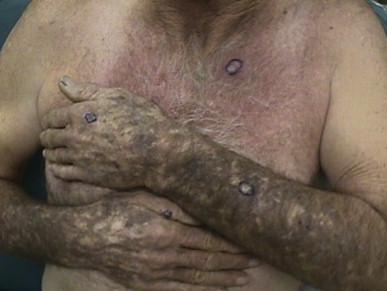Physical Address
304 North Cardinal St.
Dorchester Center, MA 02124
Solid organ transplant recipients have an increased risk of developing squamous cell carcinomas.
Immunocompromised patients can develop aggressive skin cancers with an increased risk for recurrence and metastasis.
HIV/AIDS patients have an increased risk of human papillomavirus-associated neoplasms, sebaceous carcinoma and Merkel carcinoma.
Patient education, photoprotection and close surveillance are important aspects of treatment.
The immune system has the important task of mounting a response against foreign antigens while maintaining self-tolerance. The role of the immune system in surveillance of neoplasms has long been investigated. Tumor-infiltrating lymphocytes are suspected of mounting a specific immune response to tumor antigens. Compromise of the immune system through iatrogenic or infectious means has revealed the importance of immune surveillance in monitoring cutaneous neoplasms. HIV/AIDS patients have a loss of cellular immunity resulting in an increased susceptibility to infection and risk of neoplasms. Solid organ transplant patients requiring long-term immunosuppression have the greatest incidence of non-melanoma skin cancer (NMSC), with an increased risk ranging from 50 to 100 times the general population. Although many factors contribute to the development of skin cancer in these groups, the common theme is this increased risk in the immunocompromised patient.
Improved surgical and anesthesia techniques, better understanding of immunological responses, and the development of more specific and potent immunosuppressants have revolutionized solid organ transplant in the past 60 years. Solid organ transplantation has evolved from humble beginnings with early graft rejection to over 173,000 solid organ transplant patients (SOTRs) living in the United States today. With increased success have come increased complications, most notably the development of post-transplant neoplasms. Solid organ transplant recipients have a three- to fivefold increased risk of developing malignancy, providing a unique setting for the identification of cancers under immunological control. Tumors that are seen more frequently in the transplant population include skin cancer, lymphomas, cervical and anogenital carcinomas, oropharyngeal carcinomas, renal carcinoma, thyroid carcinoma, and various sarcomas.
Skin cancer is by far the most common post-transplant malignancy. It is estimated that 44% of transplant patients will develop multiple skin cancers. Unlike the general population, transplant patients have an alarming rate of squamous call carcinomas (SCC) ( Fig. 58.1 ). The ratio of SCC to basal cell carcinoma (BCC) is 4 to 1 in these patients, a reversal of what is observed in the general population. Risk factors associated with the development of post-transplant NMSC are male sex, fair phenotype, ultraviolet radiation (UVR) exposure, degree and type of immunosuppression, age at transplantation and time from transplantation ( Table 58.1 ).

|
The strongest independent risk factor for post-transplantation NSMC is a history of NMSC prior to transplantation. Non-white kidney transplant patients do not have the same risk of developing NMSC, illustrating the importance of the patient's phenotype (Fitzpatrick skin type I–III) in the development of cancer. Most NMSCs are present in sun-exposed sites, making UVR exposure a key risk factor. Older patients with more cumulative exposure to UVR are at a greater risk for developing NMSC post transplant as compared to younger patients.
Transplant-related risk factors include time from transplantation and the intensity and duration of immunosuppression ( Table 58.2 ). Patients 50 years old or greater at transplant have an increased risk of developing skin cancer within the first year of immunosuppression. This risk increases over the next 6 years and then becomes stable. In contrast, younger transplant patients (age <50) have a delay in their relative risk of skin cancers, with the onset almost 10 years post transplant. A retrospective cohort study of renal transplant patients has shown that the use of three immunosuppressant medications is associated with an increased incidence of NMSC and a shortened time to NSMC development as compared to patients on two medications. This observation was repeated in the cardiac transplant population, showing that patients with an initial high rejection score and subsequent enhanced immunosuppression were at an increased risk of developing skin cancer. A prospective study revealed that patients with a decreased CD4 count have an increased risk of developing skin cancer. The intensity of immunosuppression varies depending upon the organ transplanted. Cardiac recipients generally require a higher degree of immunosuppression as compared to kidney patients. The age-adjusted incidence of NMSC is three times higher in heart transplant recipients than kidney transplant recipients, likely reflecting how the degree of immunosuppression correlates with the future development of NMSC.
| Tumor | Characteristics | Treatment |
|---|---|---|
| Dermatofibrosarcoma protuberans | Low-grade sarcoma High rate of recurrence Scar-like plaque on trunk and extremities |
Mohs micrographic surgery or wide local excision |
| Atypical fibroxanthoma | Spindle cell tumor on head and neck of sun-exposed patients Locally aggressive Metastatic potential |
Mohs micrographic surgery or wide local excision |
| Malignant fibrous histiocytoma | Soft tissue sarcoma on the extremities of elderly patients Metastasis to lung and lymph nodes |
Wide local excision |
| Microcystic adenocarcinoma | Locally aggressive tumor with low rate of metastasis Presents usually in central face and lip |
Mohs micrographic surgery or wide local excision |
| Sebaceous carcinoma | Eyelid is common site for presentation Metastasis Associated with Muir–Torre syndrome |
Mohs micrographic surgery or wide local excision |
* Rare non-melanoma skin cancers that have been documented in transplant patients. No increased risk for these tumors has been shown in epidemiology studies of transplant patients.
Become a Clinical Tree membership for Full access and enjoy Unlimited articles
If you are a member. Log in here